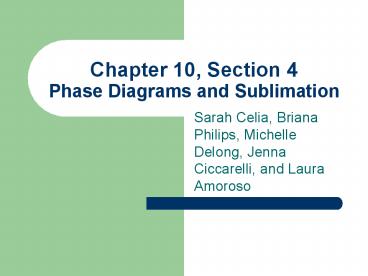Chapter 10, Section 4 Phase Diagrams and Sublimation - PowerPoint PPT Presentation
1 / 18
Title:
Chapter 10, Section 4 Phase Diagrams and Sublimation
Description:
Sarah Celia, Briana Philips, Michelle Delong, Jenna Ciccarelli, and Laura Amoroso ... The changing of a solid substance directly to a vapor without turning to ... – PowerPoint PPT presentation
Number of Views:395
Avg rating:3.0/5.0
Title: Chapter 10, Section 4 Phase Diagrams and Sublimation
1
Chapter 10, Section 4Phase Diagrams and
Sublimation
- Sarah Celia, Briana Philips, Michelle Delong,
Jenna Ciccarelli, and Laura Amoroso
2
What is Sublimation?
- Definition
- The changing of a solid substance directly to a
vapor without turning to a liquid first - Also used to describe the reverse process of gas
changing directly to the solid again upon cooling
3
Sublimation
- Examples
- Most common example is that of dry ice
- When dry ice is exposed to the air, it begins to
sublimate, or change to vapor.
4
Sublimation
- Examples (contd)
- When iodine, on being heated, changes from a dark
solid to a purplish vapor that condenses directly
to a crystalline solid upon striking a cool
surface
5
Sublimation
- Sublimation also occurs when air saturated with
water is suddenly cooled to a temperature below
the freezing point of water - Frost and snowflakes are formed by the water
changing directly from the gaseous to the solid
state
6
Evaporation vs. Sublimation
- Sublimation is what happens when a frozen
material changes to gaseous form - Evaporation is what happens when a liquid changes
to a vapor
7
Picture - Sublimation
- This is a drawing of what the surface of a comet
might look like when sublimating.
8
Picture - Sublimation
9
Picture - Sublimation
10
Phase Diagrams
- The textbook definition of a phase diagram is A
diagram that gives the conditions of temperature
and pressure at which a substance exists as a
solid, liquid, or gas (vapor)
11
Phase Diagrams
12
Phase Diagrams
- Shows the phases in different sections of the
diagram - The meeting point of all three lines on the
diagram is called the triple point - The triple point describes the only set of
conditions at which all three phases can exist in
equilibrium
13
Phase Diagrams
- The critical point is the place on the diagram
where it is not possible to distinguish between
the gas and liquid phases of an element
14
Phase Diagrams
- Using a phase diagram, you can determine the
changes in the melting point and boiling point of
a substance with changes in external pressure.
15
Phase Diagrams
- Eutectic point- defines the point where a
eutectic reaction takes place - May be none, one, or more than one on a phase
diagram - Eutectic reaction- reaction where one solid is
formed into two completely new solids
16
Phase Diagrams
17
Reference
- http//www.soton.ac.uk/pasr1/build.htm
- http//www.chm.davidson.edu/ChemistryApplets/Phase
Changes/PhaseDiagram.html - http//www.windows.ucar.edu/tour/link/comets/subl
imation.html - http//www.infoplease.com/ce6/sci/A0847062.html
- http//cosmos.swin.edu.au/entries/sublimation/subl
imation.html?e1 - http//www.physique.ens-cachan.fr/laboratoire/expe
riences/expdetail.php?IDE41 - http//en.wikipedia.org/wiki/ImagePhase-diag.svg
- http//www.fphoto.com/stockindex2006/32779302C-2RM
.jpg - http//www.mkicorp.com/includes/contents/apps/imag
es/sublimation1.jpg - Textbook
18
Acknowledgements
- We would like to thank Mr. Edsall for giving us
time to work on this project in the library.































